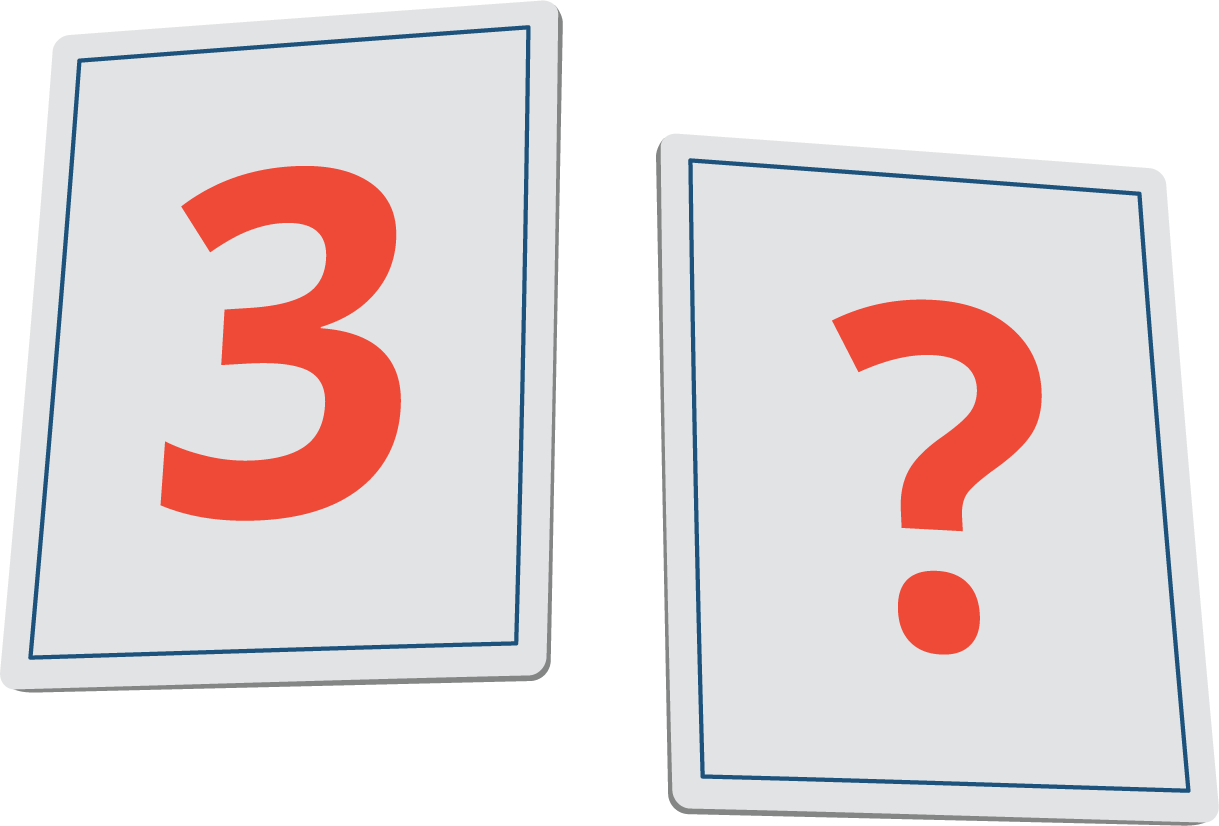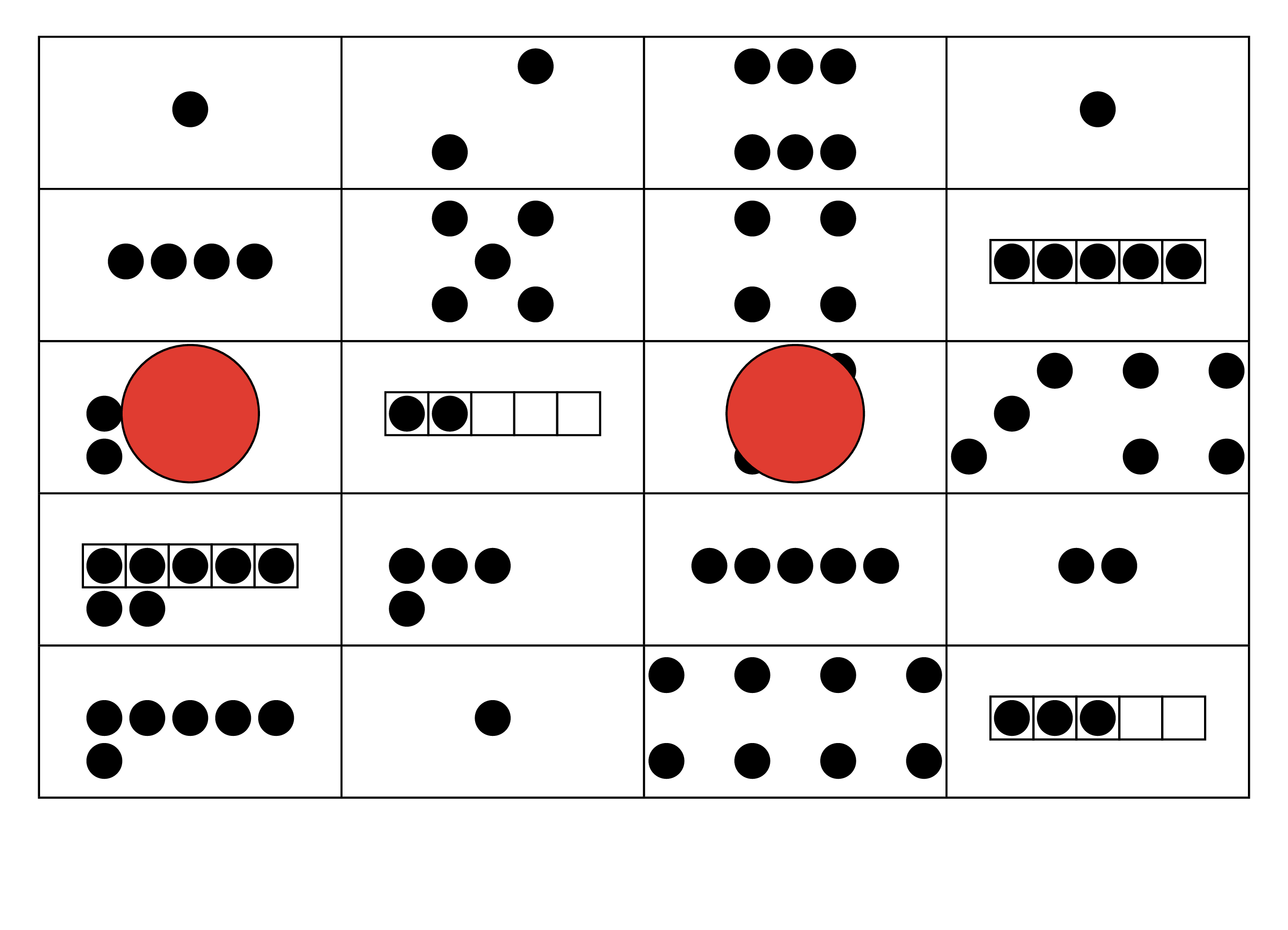Lesson 12
Count Images (Part 2)
Warm-up: Which One Doesn’t Belong: Tons of Tens (10 minutes)
Narrative
Launch
- Groups of 2
- Display the image.
- “Pick one that doesn’t belong. Be ready to share why it doesn’t belong.”
- 1 minute: quiet think time
Activity
- “Discuss your thinking with your partner.”
- 2–3 minutes: partner discussion
- Share and record responses.
Student Facing
Which one doesn’t belong?




Student Response
For access, consult one of our IM Certified Partners.
Activity Synthesis
- “What are some different ways you might see a group of things arranged?”
- “Let’s find at least one reason why each one doesn’t belong.”
Activity 1: Count Images in Organized Arrangements [OPTIONAL] (10 minutes)
Narrative
The purpose of this optional activity is for students to count groups of up to 20 images presented in lines, arrays, and on 10-frames. This activity is optional because it is an opportunity for extra practice keeping track of and accurately counting groups of up to 20 images that not all students may need. Based on formative assessment data and observation from previous lessons, this activity will be helpful for students who count some images more than one time or do not count some images. The purpose of the activity synthesis is to highlight that the order that the images are counted does not affect the number of images.
Advances: Speaking, Conversing, Representing
Launch
- Groups of 2
- “Figure out how many shapes there are. Write a number to show how many shapes there are.”
Activity
- 2 minutes: independent work time
- 3 minutes: partner work time
- Monitor for students who count the triangles by:
- counting horizontally (by rows)
- counting vertically (by columns)
Student Facing
-
There are _______________ rectangles.
-
There are _______________ dots.
-
There are _______________ hexagons.
-
There are _______________ dots.
-
There are _______________ squares.
-
There are _______________ triangles.
Student Response
For access, consult one of our IM Certified Partners.
Advancing Student Thinking
- “How many shapes are there? How do you know that you have counted each shape?”
- “What can you do to keep track of which shapes you have already counted?”
Activity Synthesis
- Display the image of triangles.
- Invite a student who counted each row to share how they counted.
- Invite a student who counted each column to share how they counted.
- “What was the same about how _____ and _____ counted? What was different?” (They both figured out that there are 16 triangles. They both counted all of the triangles. _____ counted across. _____ counted down.)
- “We can start in different places or count in a different order, as long as we count each shape 1 time.”
Activity 2: Count in Circles (10 minutes)
Narrative
The purpose of this activity is to count groups of up to 20 images that are arranged in a circle. Counting images arranged in a circle can be more difficult because there are not clear places to start and end when counting.
Students may use different methods for keeping track of the images that have been counted. They may:
- place an object such as a connecting cube on top of each hexagon as it is counted.
- color or mark each hexagon as it is counted
- mark the first hexagon that they count and touch each hexagon as they count
These methods are highlighted in the activity synthesis. Each method helps ensure that the images are counted accurately (MP6).
Supports accessibility for: Organization, Conceptual Processing
Required Materials
Materials to Gather
Launch
- Groups of 2
- Give students access to connecting cubes.
- “Work with your partner to figure out how many triangles there are in the first problem. Write a number to show how many triangles there are.”
- 30 seconds: quiet think time
- 2 minutes: partner work time
- “Pair up with another group. Did you count the triangles the same way?”
- 2 minutes: small-group discussion
- “Figure out how many shapes there are. Write a number to show how many shapes there are.”
Activity
- 4 minutes: partner work time
- Monitor for students who use the methods described in the activity narrative to count the shapes.
Student Facing
-
There are _______________ triangles.
-
There are _______________ squares.
-
There are _______________ hexagons.
-
There are _______________ triangles.
-
There are _______________ trapezoids.
-
There are _______________ rectangles.
Student Response
For access, consult one of our IM Certified Partners.
Advancing Student Thinking
If students count each image more than one time or do not count some of the images, consider asking:
- “Which shape did you count first? What can you do to know which shape you counted first?”
- “What can you do so that you know when you have counted all of the shapes?”
Activity Synthesis
- Invite a student who placed a connecting cube on each shape to share.
- “How does putting a cube on top of each shape help you figure out how many shapes there are?” (I know that I’ve already counted the shapes that have a cube on top. Once all of the shapes have a cube on top, I know that I’ve counted all of the shapes 1 time.)
- Invite a student who crossed out or colored each shape to share.
- “How does crossing out each shape help you figure out how many shapes there are?” (When all of the shapes are crossed out, I know that I have counted all of the shapes 1 time.)
- Invite a student who marked the first shape they counted to share.
- “How does marking which shape you counted first help you figure out how many shapes there are?” (If I know which shape I counted first, I can stop counting before I get back to it.)
- “Which method do you like to use to keep track of what you’ve counted in a circle? Why?”
Activity 3: Introduce Find the Pair, Make 10 (15 minutes)
Narrative
The purpose of this activity is for students to learn stage 2 of the Find the Pair center. Students practice finding the number that makes 10 when added to a given number. Each student draws a hand of 5 cards. Students take turns asking their partner for a card that goes with one of their cards to make 10. When students receive a match, they write an equation. Students draw a new card when they do not receive a match. Students may use two-color counters and a 10-frame or their fingers to help them determine the number needed to make 10.
After students participate in this center, they have a choice of centers introduced previously.
- Find the Value of Expressions
- Make or Break Apart Numbers
- Bingo
Students will continue to choose from these centers in upcoming lessons. Keep the materials from each center organized to use each day.
Required Materials
Materials to Gather
Materials to Copy
- Find the Pair Stage 2 Recording Sheet
Required Preparation
- Gather materials from:
- Find the Value of Expressions, Stage 1
- Make or Break Apart Numbers, Stages 1 and 2
- Bingo, Stages 1-4
Launch
- Groups of 2
- Give each student a set of cards, a recording sheet, and access to two-color counters and 10-frames.
- “We are going to learn a new way to play the Find the Pair center.”
- “Put all of the cards in a pile in the middle of the table. You and your partner will both draw 5 cards. Keep your cards hidden from your partner.”
- Demonstrate drawing 5 cards. Invite a student to act as the partner and draw 5 cards.
- “I am going to look at my cards. I need to choose 1 card and figure out which number I need to make 10 with the card.”
- Display a card with the number 9.
- “My card says 9. What card do I need to go with it to make 10?” (1)
- “I need a 1 card. I’m going to ask my partner if they have a 1 card.”
- “If my partner has a 1 card, they will give it to me. I will put the 9 card and 1 card down as a match and fill in an equation.”
- “If I have a 9 card and a 1 card, what equation should I write?” (\(9 + 1 = 10\) or \(1 + 9 = 10\))
- “If my partner doesn’t have the card that I asked for, I draw 1 more card from the middle.”
- Invite students to play one game with their partners and answer any questions about the rules of the game.
- “Take turns playing with your partner.”
Activity
- 5 minutes: partner work time
- “Now you can choose another center. You can also continue playing Find the Pair.”
- Display the center choices in the student book.
- Invite students to work at the center of their choice.
- 5 minutes: center work time
Student Facing
Choose a center.
Find the Pair

Find the Value of Expressions

Make or Break Apart Numbers

Bingo

Activity Synthesis
- “As you played Find the Pair, how did you figure out what number you needed to make 10?”
Lesson Synthesis
Lesson Synthesis

Demonstrate counting the triangles incorrectly. Continue counting around the circle even after you’ve counted all of the triangles.
“Did I count correctly? Why or why not?” (You didn’t count correctly because you counted some of the triangles more than one time.)
“What can I do to make sure that I count each triangle one time and that I don’t forget to count any triangles?” (You can put a cube on top of each triangle as you count it. You can cross off each triangle as you count it. You can color each triangle as you count it. You can mark which triangle you counted first.)
Cool-down: How Many Triangles? (5 minutes)
Cool-Down
For access, consult one of our IM Certified Partners.
Student Section Summary
Student Facing
In this section, we counted groups of up to 20 things.
We counted things in lines, arrays, circles, and on 10-frames.




We wrote numbers to show how many images there are.











